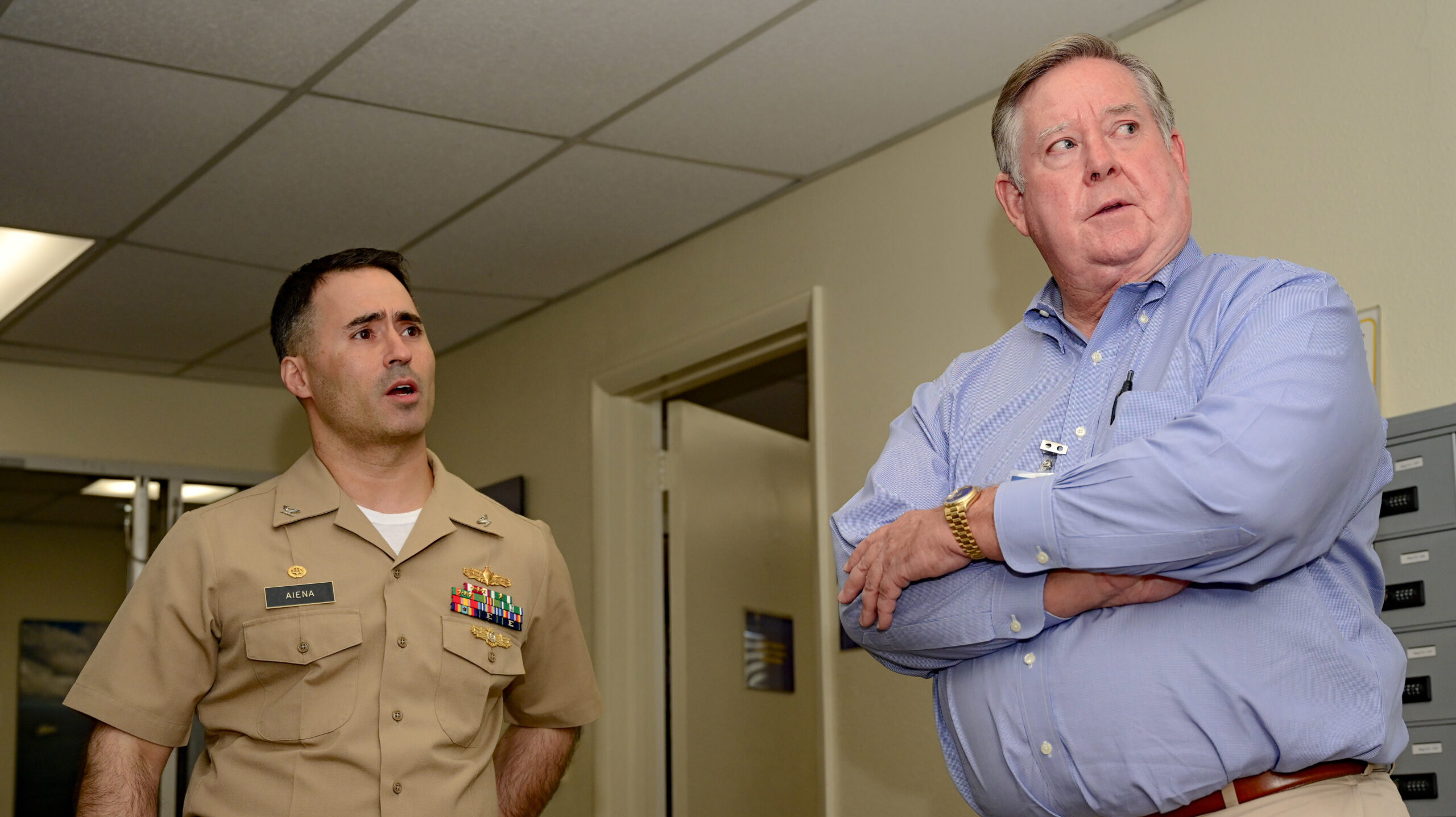REP. KEN CALVERT

Capt. Mike Aiena, left, commanding officer of Naval Surface Warfare Center, Corona Division, and U.S. Rep. Ken Calvert, 42nd District of California and chairman of the Defense Subcommittee in the House Appropriations Committee, engage in a tour of the warfare center in Norco, California, Nov. 2, 2022.
On Tuesday night, the House agreed after two failed attempts to move forward with debate on the defense appropriations bill. The man in charge of crafting that legislation is California Republican Rep. Ken Calvert, the Chairman of the House Defense Appropriations Subcommittee. In an op-ed exclusive to Breaking Defense, Calvert lays out how the language can help drive military technological innovation.
Maintaining the status quo in our defense posture will ensure that the Chinese Communist Party’s whole-of-government effort to erode American influence and power will become a reality. It is no coincidence that the first congressional delegation I led as Chairman of the House Defense Appropriations Subcommittee was to the Indo-Pacific, and that the first defense funding bill I am advancing to the House floor this week prioritizes our military superiority through technological innovation. Heightened tensions around the globe, along with the need for greater fiscal responsibility, require meaningful change to our national security enterprise.
Decades ago, US government spending was the leading driver for new technological advancement, but today, private capital for commercial technology eclipses government funding to technology development. Unfortunately, a multi-decade persistence of a culture at the Department of Defense that incentivizes near-term risk avoidance through slow bureaucratic processes has accrued long-term strategic risk to American world leadership.
Military history has taught us that it is the nation which encourages and leverages disruptive innovations first that has the upper hand. We no longer have an inherent advantage and must work twice as hard to re-establish it.
Fortunately, several years ago the DoD began to realize this risk and opportunity and started creating innovation organizations like the Defense Innovation Unit (DIU), SOFWERX, AFWERX, Task Force 59, and others. These organizations have made significant progress in accelerating and reshaping contracting and other acquisition functions with limited resources. The work of these organizations has been bolstered by initiatives such as the Accelerate the Procurement and Fielding of Innovative Technologies or APFIT program, which I fought for the creation of two years ago to bridge the gap between technically mature prototypes and the DoD’s slow budgeting process.
That said, change is hard, and these non-traditional innovation fielding enterprises have not yet achieved their full potential. The Fiscal Year 2024 Defense Appropriations Bill changes that, thanks to a proactive approach by creating a $1 billion hedge portfolio of capabilities, intentionally taking calculated risks to incentivize positive, deliberate and accelerated change.
This portfolio is a hedge against growing and innate tactical and logistical risks to current weapon systems, as well as a hedge against industrial base capacity and diversity risks. As outlined in my bill, this hedge portfolio will focus on smart, affordable, modular and sustainable systems to include low-cost, light-logistics, multi-domain drones, satellites and munitions; agile communications, computers and sensor nodes; and artificial intelligence agents and users. Networked together, these systems will create an asymmetric advantage to support combatant command operational challenges like contested logistics, electronic warfare, resilient communications and weapon and platform capacity.
The hedge portfolio funding will be managed under DIU and dispersed to Service-level Non-Traditional Innovation Fielding Enterprise (NIFE) units, to rapidly field relevant capability to the warfighter by using a new requirements development paradigm. It will drive a series of projects that begin with a clear warfighting problem and iterate to mature requirements while developing software and hardware for fielding at scale within three years by using small teams of warfighters, acquirers and technologists. This agile approach — experiment, exercise and deploy in low-rate production, potentially as a service — allows developers refining the technology to work beside the operators refining the doctrine, organization, training, materiel, leadership, personnel, facilities and policies with an unmatched pace of adoption.
The metric for success is the time it takes to field affordable and operationally relevant capability, which in turn requires letting DoD have more control over its dollars and cents. Increased warfighter flexibility can often cause heartburn on the Hill, as it feels like it often comes with a lack of Congressional oversight. But using modern business practices means the risk for taxpayers should be low, and the rewards are potentially great.
For too long, our country has relied on too few in the defense industrial base to provide for our nation’s security. With even more consolidation in the defense industrial base likely, it is essential to build broader partnerships for national security technology, talent, and capital. We must attract non-traditional partners into the defense ecosystem, while working closely with traditional defense contractors to further expand capabilities and integrate non-traditional solutions.
The culture of risk-avoidance must substantively change across all three facets of the current procurement model of requirements, budgeting, and acquisitions. Properly executed, this hedge strategy has the potential to reduce the taxpayer’s burden by leveraging private capital, to expand America’s economic advantage by accelerating emerging technology and to broaden the pool of talent supporting national defense. If America takes the preferred route and never goes to war, investment in this hedge portfolio will not only preserve peace but will also bolster prosperity by affordably ensuring America’s commercial technological advantage.
A disruptive hedge strategy empowers America’s talented entrepreneurs to move quickly with newfound flexibility in instrumented processes, enabled by rapid reporting of relevant information. Failure is to be expected when moving at a relevant pace, but with the right culture these lessons learned enable rapid iteration to achieve faster successes. It is time to adopt and rapidly scale a hedge strategy that bets on the American entrepreneurial spirit, informed by the ideals of our American democracy that values liberty, human dignity, and opportunity, to outmaneuver a rising and dangerous Chinese Communist Party.
No comments:
Post a Comment